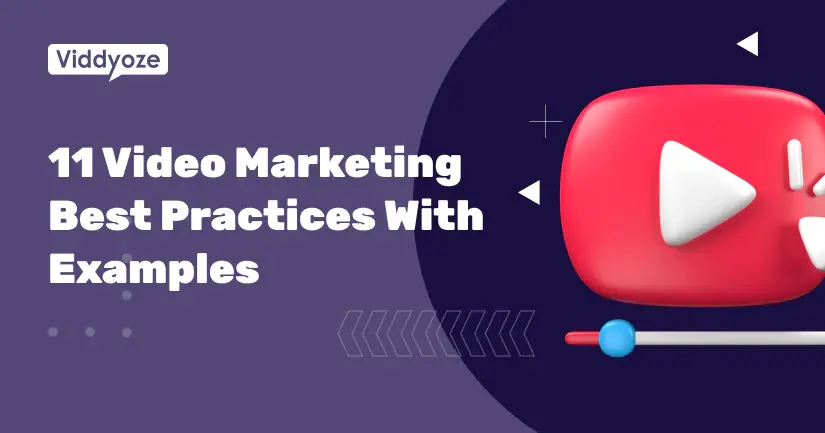It’s no secret that I’m a big video marketing advocate.
I’ve used it to build a business. I’ve used it to grow a business. And I’ve helped others use it to do the same.
That’s why I can’t understand why others still aren’t using video content in their marketing strategy. The writing is on the wall. Videos make up 82% of global internet traffic. Open up any social media app, and you’ll see a video in seconds.
They are everywhere. The rise of YouTube, TikTok, and Instagram Reels is no coincidence. These platforms are the future. I can’t really stress the importance of video marketing enough.
In my opinion, the opportunity for businesses is limitless. There are just so many different kinds of video content you can create. For example:
- Explainer Videos/ How-To Videos
- Tips & Tricks Videos
- Customer Testimonial Videos
- Interviews
- Social Media Ads, such as Facebook Videos
- Live Streams
- Demonstration/ Educational Videos
- UGC Reviews
- Case Studies
- Animated Videos
And that’s just for starters. These are just the ingredients that go into the recipe. To make a successful content marketing strategy, you’ll need to know how to mix them up the right way.
That’s why I put this handle list of video best practices together. In 11 simple steps, you’ll have the nuts and bolts to start making a video that promotes, convinces, and sells.
1. Optimize Your Video Formatting For Every Online Platform

Of all the tips for video marketing, this one is the most overlooked – and in my experience, it’s also where most businesses go wrong.
You see if you don’t make a video in the correct format for the social channel you’re posting on, your content will fail. It is that simple.
What do I mean by that? Let’s look at Instagram Stories. These videos last for 15 seconds. They’re short and snappy. So the last thing you want to do is post a 15-minute in-depth interview here – it just won’t work.
Instead, you want to take snippets of that interview. Cut it up into tasty bits. And post it to IG to tempt people to watch the whole thing. That makes sense, right?
There’s also the issue of style and size. YouTube videos tend to be horizontal, whereas Instagram Reels are vertical. Post horizontal video footage on Instagram, and it will look strange. In my experience, fewer people will watch it, and you won’t achieve your video marketing goals.
So do your research before you start making any content.
2. Hire Actors That Strongly Resemble Your Target Audience’s Demographic
When I watch an ad or video, I relate more to people similar to me.
There’s probably some deep psychological theory behind that, but for the purposes of defining the best practices for video marketing, I’ll keep it simple.
The best content works when customers see themselves in the video. Naturally, they want to have the same experience. If they can relate to the person they see – be that in age, gender, or fashion – you’ve won most of the battle already.
Check out this video from Saga. The cruise company’s target audience is older, affluent travelers, which is immediately apparent from the lead actor in this video. You don’t have to cast a famous actor like Nicholas Farrell, but it helps!
This ad from Grammarly is clearly looking for a younger target audience. I think this is aimed at students – the age of the actors, the university-style setting, and the voice-over (“If you want to write essays…”) all point to that.
The point here is to be direct. Show your audience that they are your target audience. Think about age, lifestyle, career, and spending habits. Get this wrong, and you could struggle to cut through.
As the old saying goes: if you aim to please everyone, you please no one.
3. Create A Long-Form And Short-Form Video Strategy
Using video marketing correctly means working with different lengths of content. In my experience, YouTube’s algorithm favors longer videos, while TikTok is all about shorts.
Of course, it’s not all a case of long OR short, as marketing expert Mari Smith points out in this Tweet about Facebook. Really, it depends on your video marketing campaign and the goals of the actual video.
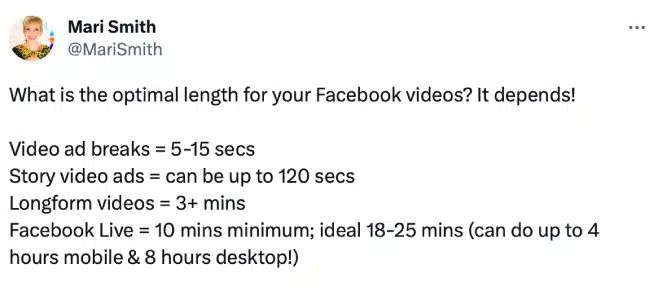
The best thing to do is create a video marketing strategy that incorporates both long AND short video content.
TikTok has ushered in a new era of short, stackable content as of late. YouTube, Instagram, and Facebook have all introduced their own version of the popular Chinese video app to combat its success.
In my experience, short videos should be entertaining and engaging. They need to pique a viewer’s interest in your brand. Look at Mr Beast. While he’s known for longer video content (an entire video can be 25 minutes long), he makes sure to create previews of his content for short platforms, such as TikTok and Instagram Reels.
To figure out what video content length you need, consider your audience, the video marketing goal, and the marketing platform. This will help you decide on a final video type and work out how long it should be.
Here are a few examples:
- Video case studies: the goal here is to educate and persuade. It’s often one of the last pieces of content a user sees before buying. With all the info you need to pack in, these tend to be longer. In my experience, between 3 and 4 minutes is fine. YouTube is the best platform.
- Video ads: the goal is to raise brand awareness and create interest in your brand. These are shorter, between 30 seconds to a minute, and can appear on any social media platform.
In terms of audience, we’re seeing younger viewers gravitate toward short videos, thanks to TikTok. Gen Z (under 20s) prefer short content, while older viewers have more patience for longer content. When creating longer content, be sure to keep it interesting, with key points spread out across the video. Retention is key, especially on YouTube.
4. Increase Your Viral Potential By Repurposing And Reusing Content
Of all video marketing best practices, this is my favorite. So many people break their necks creating video content, thinking everything has to be new and shiny.
In reality, you can repurpose and reuse what you have. Work smarter, not harder, guys.

Amy Porterfield is an expert at this, and you can find out why here. I’ve also got some tips for you.
Here’s a quick example of how to repurpose content on TikTok. A few weeks ago, I posted a short video on the platform that got a ton of views. Because of how well the video did, I reposted the exact same video again a week later. The results were still great. A successful video on TikTok will often work more than once.
Another thing you can do is post your TikTok video to other shorts platforms, such as Instagram Reels and YouTube Shorts. The format is almost identical, so maximize your content by posting one video across 3 different platforms during the week.
The other thing I like to do, I’ve already spoken about. It’s the same thing Mr Beast does. With all longer videos – brand videos, video tutorials, customer testimonials, product videos, etc. – I make shorter videos for Reels or TikTok or to be used as an ad.
A 4-minute video can be used to make 2 or 3 shorter types of video marketing content.
5. Utilize User-Generated Video Content To Give Shoppers The Confidence To Buy
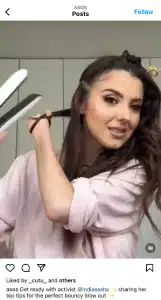
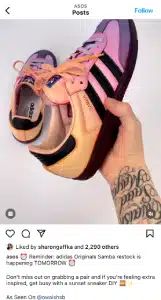
User-generated content (UGC, for short) is any content an influencer or user creates for your brand.
These examples above from ASOS cover it pretty well. In the first, influencer India Sasha shares her tips with a short video. In the second, a user shares a photo of the product ASOS is promoting.
In both cases, ASOS is using a piece of content someone else has created to promote the brand. So why do businesses use it? First, it usually costs less (unless you’re paying an influencer). Many people will create UGC for exposure or the chance to win a prize.
Second, it builds social proof and trust. Real people sharing content about your brand makes other people sit up and take notice. They think, “Well, that person trusts this brand, so maybe I should too.” It drives a strong emotional response and also creates FOMO.
Here’s another brilliant example, this time by GoPro. There’s nothing revolutionary about this ad. All GoPro has done is ask users to make a movie doing something they love, whether that’s diving, snowboarding, or skateboarding. It’s a great content marketing strategy because it shows people using the product exactly how it’s meant to be used. Plus, it looks like fun.
When asking users to make UGC, be sure to make it clear that it will be used in a promotion. You should also outline exactly what you want from each video – all great marketing videos do this.
Here’s how I would do it if I were running a UGC campaign for Viddyoze:
1. Tell people – promote it on all social media platforms
2. Explain what I want – for example, I could say, “Share a video you’ve created using Viddyoze”
3. What’s in it for the user – give an incentive, such as “the best video marketing wins a prize”
4. Tell them how to share – create a hashtag or come up with some other way of collecting the content
6. Use Animations To More Subtly Call Your Viewers To Action
A good call to action (CTA) can supercharge almost any type of content. Its purpose is simple: it tells your audience what you want them to do.
Whether you want them to buy, subscribe to your newsletter, or visit your website. Marketing videos for business need to have a clear, direct CTA.
Why? Just check out this stat from Michael Aagaard. The conversion consultant managed to increase the conversion rate of a landing page by a frankly insane 304% just by adding a CTA button.
It can do the same in a video. I know because I’ve seen the results. That’s why CTAs are on this list of must-follow video marketing practices.
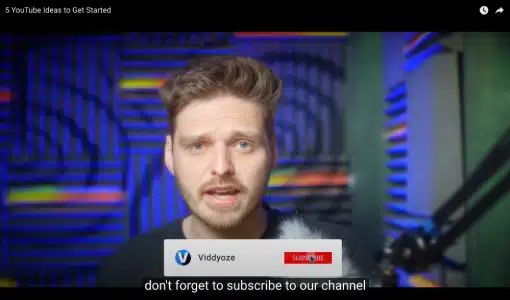
With video, it’s important to make your CTA stand out from the rest of your high-quality video footage. In my opinion, animations are the best way to do this. They catch the eye and look great – especially if used over live-action footage – check out this one at 5:23 in our video “5 YouTube Ideas to Get Started“.
Animated CTAs are simple and easy to use. You can add one into a video in seconds using Viddyoze. See how to make an animated CTA with this short video guide.
But where should you put them? I like having between 2 and 3 CTAs in my videos. One at the beginning, one in the middle, and one at the end. That way, you get your message across, even if the viewer doesn’t watch the whole thing.
7. Get Your Video Marketing Funnel Crystal Clear For Maximum Success
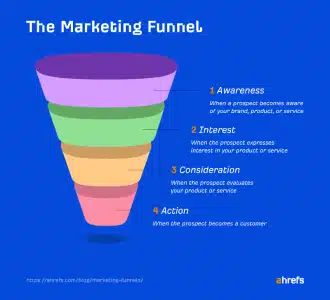
A marketing funnel is the journey a buyer takes, from the first moment they hear about your brand to the moment they complete a sale to the moment they come back for more.
Building a marketing funnel is essential to your success. And good video content is essential to building an effective marketing funnel.
So, how does it work?
A good marketing funnel works like this. Typically, there are 5 stages in the buyer’s lifecycle, depending on the theory you subscribe to. I like the 5 stage process, so that’s what I’m talking about here.
Those 5 stages are:
- Awareness
- Interest
- Consideration
- Conversion
- Loyalty
At each stage, you need to serve your potential customer with a specific type of content. This is because content types vary greatly. A customer testimonial might close the deal, but it’s less likely to get people interested than, say, a product video.
Here’s a short example of how a funnel can work using Dog Bites, a dog food company I made up:
Awareness – a sales prospect reads a blog about the nutritional factors dog food should have for optimal dog health on the Dog Bites’ website. They arrived here through Google or clicked on an ad.
Interest – the prospect is curious, and they want to know more. Embedded in the blog is a YouTube video called: “Nutritious Snacks to boost your dog’s Well-being and Lifespan.” They click and watch.
Consideration – they like what they see but don’t quite trust Dog Bites yet. They’re considering the product but want to know more. They do some digging, read some reviews, and watch a testimonial video on your site.
Conversion – the prospect searches for “Dog Bites vs. Lily’s Kitchen” (another dog snack brand) and finds a video made by an influencer raving about the Dog Bites product. Finally, they decide to buy.
Loyalty – through email, Dog Bites follows up with deals, weekly news videos, new product videos, and more.
8. Apply A Storytelling Framework To Your Videos For Memorability
Creating videos is much more than pointing a camera and hitting records. The good stuff – I’m talking about that top-tier, gold-standard video marketing for business – always has a story at its core.
Why? Because a good story pulls people in. It triggers an emotional reaction. UK retailer John Lewis is the master of this. Every year, millions of people await its Christmas ads, not because they’re desperate to buy from John Lewis, but because the brand has mastered the art of storytelling.
But it’s not all emotional. There’s some science in there, too. I’ve used this stat a million times, but I’m going to throw it out there again because it’s important: “The human mind is 22x more likely to remember facts when presented within a story format”.
Tell someone a good story, and they’ll remember your brand somewhere down the line. When they finally come to make a sale, this could be vital.
But how do you do it?
A lot of the small businesses I talk to find this kind of thing daunting. They see storytelling as something above them, something unobtainable. That is not the case.
Anyone can create an engaging story that pulls in video views; they just need to know how to use a storytelling framework.
One of the most well-used is the Pixar Framework. Every movie Pixar has ever made has followed this video planning and storytelling framework. We go into it in more detail here, but essentially, this is a proven formula that can be used for B2B video marketing.
Don’t fancy that one? We’ve got 2 more for you to choose from. Just hit the link above and start utilizing stories in your campaigns and marketing strategies.
9. Get More Clicks With Standout Video Thumbnails

You might not think it, but your video thumbnails are important for getting clicks.
This is especially important for YouTube, where the thumbnail can be the difference between your video and a competitor’s.
I’ve created so many thumbnails, and every time I stick to the same principles:
- Use bright colors, such as reds, blues, and yellows, and large, plain text
- Feature the video’s title
- Match colors to your social media branding
- Feature a human face (usually the host) looking directly out of the photo
Check the thumbnail above: the spacing is great, and the text is clear and readable as it’s large, simple, and white against the black background. The yellow I’ve used is eye-catching and really stands out.
I use Photoshop to create my thumbnails, but you can also do it for free on Canva if your budget is tight.
10. Prepare A Video Promotion And Distribution Plan For Views
Distribution is important for any video marketing plan. You can’t just post a video and hope people will find it. In my experience, people only watch videos when they’ve been directed to them.
How you promote your videos depends on your budget and your overall strategy. I’d recommend a combination of email, social media, paid ads, and SEO.
Email: every time you post a new video, send an email notification to your existing subscribers. You’ll drive early views, which in turn gives your video better traction on video platforms such as YouTube.
Social media: use a combination of organic and paid posts to let people know you have a new video. Organic will reach your existing followers, while paid will pull in new ones.
Paid ads: ads are a proven way to drive traffic and improve your video marketing statistics. You can use video ads on social media and YouTube and banner ads on Google.
SEO: pull in organic traffic with SEO-optimized video content. For a detailed video marketing guide on how to do this, check out this blog post.
11. Comment On Your Own Videos To Stimulate Conversation And Boost Engagement
These days, social media platforms are all about engagement. In many cases, their algorithms are designed to reward it. Using videos for marketing is a great way to encourage interaction with your brand.
The more comments, likes, and shares your content gets, the better it will perform organically. Think of it this way. If your users are commenting on your content, they’re spending more time on a platform – social media companies love this.
I like this quote by Mari Smith, which sums it up nicely. Engagement really is the queen.
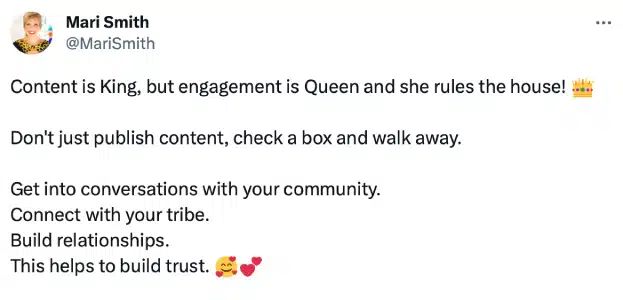
Obviously, the best way to drive engagement is with valuable, quality digital marketing video content. If your video marketing strategy is packed with awesome ideas, you won’t need to worry about this.
It’s also a good idea to ask people to like and subscribe at the beginning of your video (see my point about call to actions earlier).
As for comments, again, it’s okay to ask people to leave comments. I like to ask questions during the video and prompt viewers to leave their answers in the comments. This is also one of the great video marketing tactics for coming up with new ideas.
Here are a few of my favorites:
- What kind of video would you like to see next?
- Did you find this video useful? Let us know in the comments!
- Have I missed anything on this topic? Tell me in the comments.
Final Words On Best Practices For Video Marketing
The big thing I want you to take away from this blog is that using video in marketing doesn’t have to be difficult. In fact, it can be unbelievably easy.
Want to make it even easier? Try our free trial and create your first video at zero cost. It’s so easy you can create videos in a matter of minutes – even if you’ve never done it before.
I’ve given you the ingredients. I’ve given you the recipe. Now it’s time to fire up the oven and start cooking.
For more on video marketing, check out our 20 Video Marketing Trends or more Video Marketing Tips for Websites.
